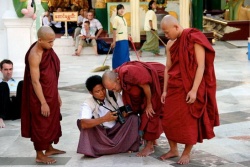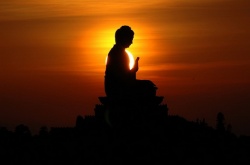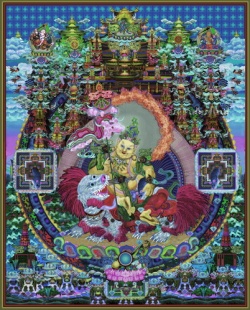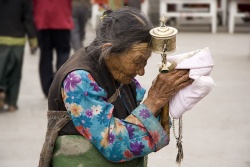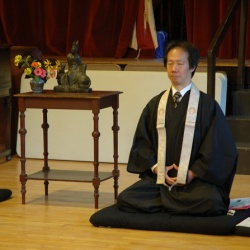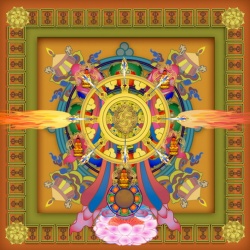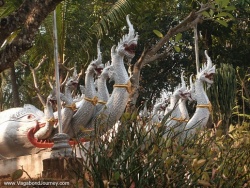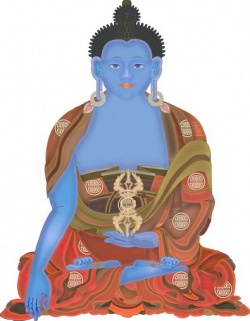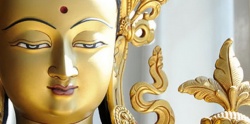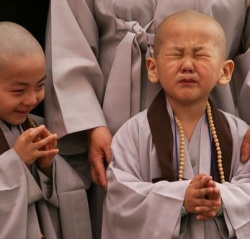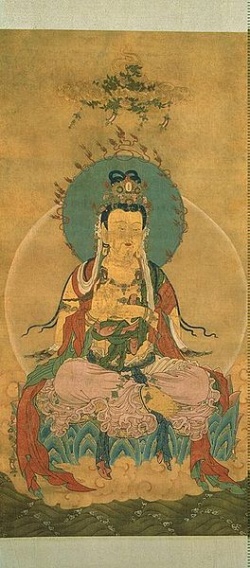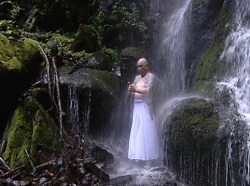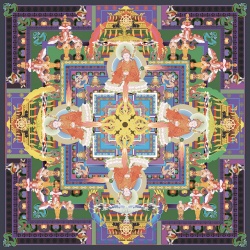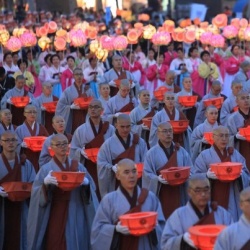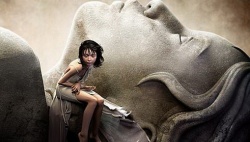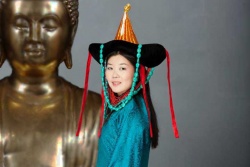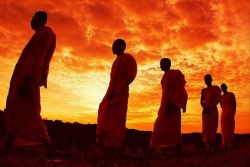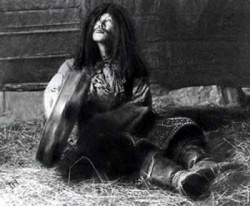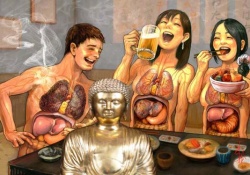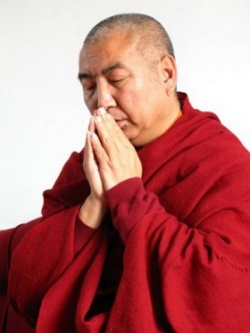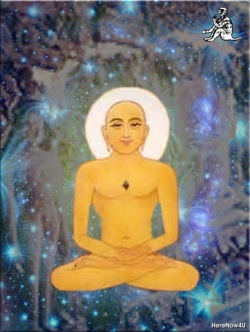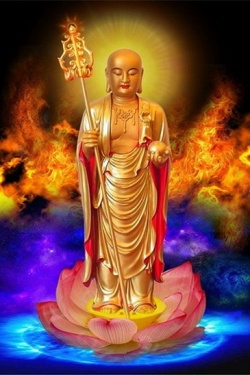Atta in Brahmanism
There are four kinds of persons (Sotapanna,Sakadagami,Anagami,and Arahant) according to their different enlightenments.These four persons are called Ariya.
Sotapanna
The person who got the first enlighenment of Nibbana called Sotapanna Magga is sotapanna person.Sotapanna Megga has eliminated the Sakkaya -ditthi (egoistic wrong view) and (sakkaya-ditthi), atta-ditthi and doubt (vicikiccha) about Dhamma. Your attention is then towards the cessation of suffering. That borderline knowledge is known as Gotrabhu-nana. 'Gotra' means Puthujjana or descendants. On this border, descendants of a Puthujjana are cut off totally. Then there is no more Puthujjana. Once you pass that borderline, you become a Noble One (Ariya) because you have cut off the Puthujjana lineage.
When a meditator has attained purification of mind, his mind becomes sharp enough to penetrate into the true nature of the mind-body processes. Then he distinguishes between the mental and physical processes and realises the specific characteristics of mental and physical phenomena. This is the first stage of insight. When he can realise the specific characteristics of mental and physical phenomena and can distinguish between nama and rupa, he can destroy sakkaya-ditthi and atta-ditthi for the time being. At this stage of insight, he has uprooted sakkaya-ditthi and atta-ditthi. When he is not experiencing this insight, sakkaya ditthi and atta-ditthi will come back to him, although not strongly. Sakkaya-ditthi is only uprooted or exterminated by attaining the first stage of enlightenment, Sotapatti-magga- nana.
Atta in Brahmanism
We should understand the concepts of sakkaya-ditthi and atta-ditthi from the point of view of Hinduism.
According to Hinduism or Brahmanism, the whole world was created by Mahabrahma. This Mahabrahmahas many names such as, Isvara, Paramatma and Prajapati. 'Pati' means creator or master. Prajameans creatures or living beings. So he is the master of living beings because he created them.
Paramatma is a Sanskrit or Hindu term. In Pali it is Paramatta. When wedivide this Paramatma into two words, it is Parama and atma. Here parama means the noblest, the holiest; 'atma' means soul or self. So Paramatma means the holiest soul. Some translate this word as the big self or big soul. This soul is big enough to create the world and living beings. When the condition of the world was good enough for living beings to live in, he created all living beings- men, devas, Brahmas,and animals. He even created tigers, lions and poisonous snakes, which are a great danger to man. When Mahabrahma or Paramatma first created living beings, they were like corpses; they could not move, sit or stand. Then Mahabrahma wanted to make these creatures come to life. So he put a soul into each creature or living being.
Then all the creatures got up and moved, stood, sat and so on. In this way, that small soul or self existed in every living being according to Brahmanism. Even an insect has a small soul in it. That soul is called Jiva-atta. It is everlasting and indestructible and cannot he destroyed by any means, even an atomic bomb, because it is supported by Mahabrahma or Prajapati. But when this body is about to disintegrate, that soul knows that the body is about to disintegrate - so it has to be prepared to leave that body and reincarnate into another body.
It has to take existence either in a lower or higher world, depending on its kamma in this life. If that soul performs meritorious deeds in this life, these meritorious deeds are good kamma so they lead the soul to a higher level of existence. When the soul reincarnates into another body, we call it reincarnation. But that everlasting soul, jiva-atta or self cannot be destroyed in the next existence either. So the cycle of reincarnation continues.. This is what Brahmanism believes about soul. In short. according to Brahmanism, there is an everlasting entity in us, the so-called self, soul or ego.
That belief or concept of an everlasting entity, soul, self or ego, known as Atta-ditthi, is due to the non-realisation of the true nature of the natural processes.
Attta in Buddhism
We are not Hindus but we have the concept of a soul, though the concept is not so strong because we follow the doctrine of the Buddha. We understand theoretically that there is no soul or self or that there is no everlasting entity, yet we believe that when a person dies, the soul comes out of the body and stays near his house or his corpse or his coffin. It Is a common belief that if we do not make offerings to the monks (bhikkhu ) and have not shared our meritorious deeds with the departed ones, the soul has to live around us.
Though we believe the doctrine of the Buddha, we still have this concept of atta-ditthi, and based on this concept we have another concept of personality, individuality, a being, a man or a woman -sakkaya-ditthi (sakkaya here means nama and rupa, ditthi means wrong or false view). We have this concept because we do not comprehend the specific and common characteristics of the mind-body processes; we take them to be everlasting.
If you ask yourself, "Will I die tomorrow?" - you dare not answer the question. If I say you are going to die tomorrow, you will get angry with me because you have the idea of permanency of mental and physical processes. You think your mind-body processes are permanent; at least until tomorrow. Yes, that is the idea of permanency. You hold it because you have not realised the appearance and disappearance of the process of mental and physical phenomena. If you see the constant, instant appearance and disappearance of mental and physical phenomena, you will not believe them to be permanent.
Theoretically you understand that none of the mental and physical processes last even a second according to the doctrine of the Lord Buddha, but practically you do not believe it because you have not realised their impermanent nature. Only if you have personal experience of the Dhamma, do you conclude that it is impermanent. You can then accept, "I may not even live until tomorrow. I may die this very second because every phenomena is subject to impermanence Actually, when a man has not realised the arising and passing away of mental arid physical phenomena, he takes them to be permanent. The idea of personality is based on the belief in a permanent entity within us. So atta-ditthi and sakkaya-ditthi are the same.
If we say, "Now I am lifting my hand", then you ask me who is lifting the hand. I will say, "I am lifting the hand." Who is that 'I'? A bhikkhu, a man, or a being who is living? If we do not believe in the permanent nature of mind-body processes, we do not take them to be a being. But actually, the dual process of mentality and physicality which constitutes a so-called person is subject to change, arising and passing away but we do not realise it. We take this dual process to be a person, a being, a dog or an animal. This view is called sakkaya-ditthi. Unless we can rightly comprehend these mind and body processes in their true nature we are unable to overcome or destroy this false view.
That is why the Buddha teaches us to be mindful of any activity of mind and body, or any mental and physical processes as they really are, so that we can realise the two processes as natural processes. This insight is called knowledge of Sabhava-lakkhana (right understanding of the specific characteristics or individual characteristics of mental and physical phenomena). This insight knowledge destroys the concept of soul or self, person or being which is the main cause of defilements (kilesas) such as greed, anger, delusion and conceit and so on. So we can say that this concept of a soul or a self is the seed of all defilements. When we have exterminated the seed there will not arise any defilements and we have got rid of suffering. That is:
Sakkaya-ditthi pahanaya sato bhikkhu paribbaje.
'Sakkaya-ditthi pahanaya' means to overcome this false view of a soul, a self or a person; 'sato' means mindful; bhikkhu means monk. A bhikkhu who is mindful of phenomena must strive or practise to overcome the false view. When he is able to destroy that sakkaya-ditthi, he is sure to deliver himself from all kinds of suffering. This sakkaya-ditthi is the cause of all kinds of defilements or the seed of all defilements. So we have to try to exterminate it through right understanding of mental and physical processes by means of mindfulness meditation.
Arahant
Let me summarize some of characteristics
1) already eliminated all the cetasikas and defilements
2) already eliminated all kinds of Karma that will cause of next life(rebirth)
3)No fear( Even when the lightning occur near Arahant,When the very big and frightening sound occur near Arahant, there is no fear in the mind).No fear of death
4)Must convert to monk form if he get the four enligthenment with human clothes.
5)No more feeling coming from Six sense of doors(eye,ear,nose,tongue,body and mind)(For example, when he see very beautiful girl, his eye consiousness has neither beautiful nor ugly.When he see the very bad image, his eye consiousness has neither good nor bad .He only has natural eye consciousness on the object.)
6)No more attachment to name convention coming from six sense of doors(eye,ear,nose,tongue,body and mind)(For example,we can give any name to all the matters and mind to be easy to understand.let say after one invent new electronic deivce, one give the name to it to be called computer.Hence, everyone follow him to use computer term for new device so that everyone can understand it.Actually there is no computer.It is just only name.Anybody can give any name to this new electronic devices. Electronic device is only matter) .Arahant will use name to explain the Dhamma for people to understand.But there is no attachement to name
7)Before Arahant pass away, he may or may not be determined to let his body becomes relics.Most of Arahant is determined to let his body becomes relics before passed away for the people to pay homage his relics.After we burn the Arahant dead body , his body becomes relics.
8) No more rebirth after passed away( Already in his Nibbana. Nobody in this world cannot awake or call him to come back because Nibbana has no cause and effect with any Dhamma)
Magga Appanà Vãthis
Those, who undertake insight-meditation, meditate on the three characteristics of existence (ti-lakkhaõa) namely, impermanence (anicca), suffering or misery (dukkha) and not-self (anatta). After developing ten insight-knowledges (vipassanà-¤àõas), the realization of the Path and its Fruition (magga and phala) follows up. There are four levels of magga and phala. The maggaappanà vãthis run as follows.
(Manda-pa¤¤à)
Na–Da– “Ma–Pa–U–Nu–Go–Mag–Pha–Pha”–Bha– (Tikkha-pa¤¤à)
Na–Da– “Ma–U–Nu–Go–Mag–Pha–Pha–Pha”–Bha–Bha– 1 When one of the three characteristics of existence enters the avenue of the mind-door of a puthujjana (worldling or one who is bound by all ten fetters), the lifecontinuum vibrates twice and becomes arrested (Na- Da). Then, observing and considering the characteristics of existence, mano-dvàràvajjana (Ma) arises once. Then one of the four ¤àõa-sampayuttaü mahà-kusala cittas, observing the characteristics of existence, functions three times as parikamma (Pa), upacàra (U), anuloma (Nu), and then, observing Nibbàna, functions once more as gotrabhu (Go). Then sotàpatti-magga javana arises once observing Nibbàna. Then, without any lapse in time, the fruition of the magga, i.e., sotàpatti-phala citta, functions twice as appanà-javana. Then bhavaïga cittas sink into life-continuum and the person comes out of magga-vãthis. (If the person is of tikkha-pa¤¤à, parikamma
is omitted and phala-javana occurs three times.)
Note:
In the above magga-vãthi, parikamma, upacàra, anuloma and gotrabhu signify the following things: Pa: parikamma: preparation of magga, U: upacàra: proximity of magga,
Nu: anuloma: adaptation or connection; it harmonies the lower cittas with the upper cittas, Go: gotrabhu the citta that cuts the puthujjana-lineage to form the ariya-lineage (ariya – holy).
Once a person becomes an ariya, he is never reverted back to a puthujjana again. Thus gotrabhu has to cut the puthujjana-lineage only once. So in later magga- and phala-vãthis, Vo – vodàna (meaning purification) is inserted in place of Go – gotrabhu.
2 To realize the second magga and phala, the sotàpanna or sotapan (stream-winner who has realized the first magga and phala) has to meditate on the three characteristics of existence again. When the second magga-vãthi arises, it runs as above—the only changes necessary are: ‘vodàna’ in place of ‘gotrabhu’, ‘sakadàgamà-magga’ in place of ‘sotàpatti-magga’ and ‘sakadàgamà-phala’ in place of ‘sotàpatti-phala’. After this second magga-vãthi, the person becomes a sakadàgamà or sakadàgam (once-returner, i.e. he will return to the kàma-abodes just once).
3 If the sakadàgam undertakes insight-meditation further, he may develop the third magga-vãthi which runs as the second magga-vãthi—just change ‘sakadàgamà’ into ‘anàgàmi’. The person now becomes an anàgàmà or anàgam (non-returner, i.e., he will not be reborn in the kàma abodes again).
4 If the anàgam undertakes insight-meditation further, he may develop the fourth magga-vãthi. This vãthi again runs as before—just change ‘anàgàmà’ into ‘arahatta’. The person now becomes an arahant (the perfect one). Phala-samàpatti Vãthis
There are four noble individuals (ariya-puggala): the streamwinner (sotàpanna), the once-returner (sakadàgamà), the nonreturner (anàgàmà) and the perfect one (arahat). Each noble individual may enter the meditative absorption corresponding to the fruition of the path he has attained. By doing so, he is enjoying the peace of Nibbàna, and during this absorption phala-samàpatti vãthis occur as follows. (Manda-pa¤¤à)
Na–Da– “Ma–Pa–U–Nu–Vo–Pha–Pha– many times” Bha– (Tikkha-pa¤¤à)
Na–Da– “Ma–U–Nu–Vo–Pha–Pha– many times” Bha– In developing the phala-samàpatti vãthis, the noble individuals have to meditate on the three characteristics of existence until the phala-samàpatti vãthi arises.
1 When one of the three characteristics of existence enters the avenue of the mind-door of a sotàpanna, the life continuum vibrates twice as bhavaïga-calàna and bhavaïgupaccheda and becomes arrested. The manodvàràvajjana considers the object and decides whether it is good or bad. Then one of the four ¤àõa-sampayuttaü mahà-kusala cittas, observing the tãlakkhaõa object,
functions three times as parikamma (omit in tikkha-pa¤¤àperson), upacàra and anuloma, and, observing Nibbàna,functions once as vodàna. After that sotàpatti-phala citta,observing Nibbàna, functions as appanà-javana many times as long as the person wishes up to seven days. Then bhavaïga cittas sink into life-continuum and the person arises from phala-samàpatti.
2 When one of the three characteristics of existence enters the avenue of the mind-door of a sakadàgamà, the life continuum vibrates twice as bhavaïga-calàna and bhavangupaccheda and becomes arrested. The manodvàràvajjana considers the object and decides whether it is good or bad. Then one of the four ¤àõa-sampayuttaü mahà-kusala cittas, observing the tãlakkhaõa object, functions three times as parikamma (omit in tikkha-pa¤¤à person), upacàra and anuloma, and, observing Nibbàna, functions once as vodàna. After that sakadàgamà-phala citta, observing Nibbàna, functions as appanà-javana many times as long as the person wishes up to seven days. Then bhavaïga cittas sink into life-continuum and the person arises from phala-samàpatti. 3 When one of the three characteristics of existence enters the avenue of the mind-door of anàgàmà, the life continuum vibrates twice as bhavaïga-calàna and bhavaïgupaccheda and becomes arrested. The manodvàràvajjana considers the object and decides whether it is good or bad. Then one of the four ¤àõa-sampayuttaü mahà-kusala cittas, observing the tãlakkhaõa object, functions three times as parikamma (omit in tikkha-pa¤¤à person), upacàra and anuloma, and, observing Nibbàna, functions once as vodàna. After that anàgàmi-phala citta, observing Nibbàna, functions as appanà-javana many times as long as the person wishes up to seven days.
Then bhavaïga cittas sink into life-continuum and the person arises from phala-samàpatti.
4. When one of the three characteristics of existence enters the avenue of the mind-door of an arahant, the lifecontinuum vibrates twice as bhavaïga-calàna and bhavaïgupaccheda and becomes arrested. The manodvàràvajjana considers the object and decides whether it is good or bad. Then one of the four ¤àõa-sampayuttaü mahà-kusala cittas, observing the tãlakkhaõa object, functions three times as parikamma (omit in tikkha-pa¤¤à person), upacàra and anuloma, and, observing Nibbàna, functions once as vodàna. After that arahatta-phala citta, observing Nibbàna, functions as appanà-javana many times as long as the person wishes up to seven days. Then bhavaïga cittas sink into life-continuum and the person arises from phala-samàpatti.
Nirodha-samàpatti Vãthi
‘Nirodha-samàpatti’ means ‘attainment of extinction’. This vãthi is developed to suspend temporarily all consciousness and mental activity, following immediately upon the semi-conscious state called ‘sphere of neither-perception-nor-non-perception’ (nevasa¤¤à-n’àsa¤¤à-yatana jhàna). Only anàgàmi or arahant who has mastered all the nine absorption (jhànas) is able to develop the nirodha-samàpatti vãthi. The procedure for developing the nirodha-samàpatti vãthi is as follows.
First of all the person enters the råpàvacara first-jhàna, comes out of it and meditates on the jhàna components as to their
characteristics of impermanence, suffering and non-self. He repeats this procedure with the råpàvacara second-, third-, fourthand fifth-jhànas, and then also with the aråpàvacara first-, secondand third-jhànas.
Then he makes four resolutions (adhiññhàna). 1 May I remain in nirodha-samàpatti for one hour, two hours…, one day, two days…, or seven days (provided the period does not exceed his life-span which he can know).
2 May my body, the things I am using and the building I am living be not harmed nor destroyed by any means (he can demarcate the area as much as he likes). 3 May I come out of the nirodha-samàpatti as soon as Lord Buddha wishes to see me (this is at the time when the Buddha is alive).
4 May I come out of the nirodha-samàpatti as soon as the congregation of monks wishes my presence (this is done out of respect for the congregation of monks). Now the person develops the aråpàvacara fourth-jhàna and soon after the occurrence of neva-sa¤¤à-n’àsa¤¤à-yatana citta as appanà-javana for two conscious moments, the stream of consciousness is cut off—no cittas, cetasikas and [[cittaja-råpa] (corporeality formed by citta) arise any more. The person will remain in this state of extinction of consciousness, its concomitants and cittaja-råpa till the end of the period he has resolved to remain in nirodha-samàpatti. Though he does not breathe, eat, drink or know anything, he is still alive. When he comes out of the nirodha-samàpatti, anàgàmà-phala citta arises once as appanà-javana if he is an anàgàmi, or arahatta-phala citta arises once as appanà-javana if he is an arahant. Then bhavaïga cittas sink into life-continuum.
A Detailed Account of the Life Story of the late Sun Lun Gu Kyaung Sayadaw(Arahart)http://www.dhammaweb.net/sunlun.html
(This detailed life story is a record of what was heard from the mouth of the late Sun Lun Gu kyaung Sayadaw of Myingyan.)
It is the inherent nature of an Ariyā to be obsessed with a persistent desire for escape from the perilous round of rebirths, characterized by constant perishing of mental and material phenomena. One such Ariyā to be, faring in SaÑsarÈ’s innumerable existences, happened to be born as a parrot during the time of Kassapa Buddha who appeared in the Bhadda-kappa (the present world) which is blessed by Five Buddhas.
One day, the parrot happened to meet Kassapa Buddha. Being endowed with innate wisdom, he knew that it was a Noble Personage. He was inspired to pay homage to the Buddha. He offered a fruit to the Buddha respectfully with his wings touching each other above his head. The Buddha out of compassion accepted the bird’s gift and said, “May all your wishes come to fulfillment”. The parrot watched the Buddha with revered eyes as the Buddha departed, his little heart full of joy, uttering “O, what a good deed I have done!” Since the donee was the Buddha himself and the donor made his gift with strong conviction, the resultant was bound to be fruitful.
The parrot was reborn in the good destinations of the seven planes of sensual existence under glorious circumstances. After faring in a number of Celestial realms, he was reborn in the human world as a great Tikicchaka Physician (N.B. The Sayadaw once said: “Those who had met me during my existence as a great Physician will come to me now and take up the practice of Dhamma under me.”) During the time of Gotama Buddha, the great Physician was reborn as the famous Barr-mai Sayadaw, mentor to King Man|hā of Thaton, Thuwanna Bhumi, the great patron of the Buddha’s Teaching. After passing away from that existence, the future Sun Lun Sayadaw was reborn as a child of U Thant and Daw Tok of Sun Lun village in the southern part of Myingyan Township in Upper Burma. (N.B. During the British administration the country was divided into Upper Burma and Lower Burma, the upper region being still under Burmese King.)
At the time of conception, the father had a dream in which a man of noble appearance came to his house and asked for permission to stay in the house. U Thant told that man, not to stay with his family because he was very poor. Although he refused many times, the stranger insisted to stay, and at last had to agree. The family took the dream as auspicious. The mother Daw Tok after nine months of pregnancy, in the tenth month give birth to the child, the future- Sun Lun Sayadaw, at the few minutes before 4 am on the second waning day of Tabaung (March) in 1239 ME, which was the year 2421 of the Sāsanā Era. The child had a particularly bright appearance. At the time of naming him, with the usual washing of the hair, in view of the good omens, he was named Maung Kyaw Din (Meaning Master Famous).
(U Thant and Daw Tok had three children; Ma Thinn, Ko Kyaw Din and Ko Aung Khaing).
Ko Kyaw Din was placed under the Min-Kyaung Sayadaw of Myingyan for his education. He was a dull pupil and did not get far in his studies. So his father U Thant found him a menial post like his, in the office of the Deputy Commissioner of Myingyan.
When Ko Kyaw Din grew up, he married Ma Shwe Yi of his native village. The couple begot four children but three died in infancy and only a son by the name of Ko Shein (a) Ko Kan Nyunt survived to this day.
Ko Kyaw Din thought that his work as an office-boy in government office held no good prospects and resigned the job at the age of thirty. He worked as a cultivator in the family estate, a dry patch of land. One day, one U San Tin, said to achieved occult powers and was patronized by the (four) Great Guardian Kings of Catumahārāja DevÈs Realm, came to him and recited some strange prophetic words without any context. His words roughly might be translated that:
“Amai Bok’s skeins got tangled, who’s there to clear up this mess? The shuttle moves along amidst the threads of skeins.
The ruined stump of the pagoda emits rays! Ma Khway is
dressed in the beautiful longyi of ‘Pondaw’ design with a green fringe and a checkered blue. The weaver’s gear made of ‘Kyun-bo’ teak puts forth a sound that can be heard from a distance of ten thousand Y|janās.”
U San Tin then explained his words as follows: “The skeins that are tangled get entangled when put to the loom, isn’t it?”
“Yes, of course”
That being so, U Kyaw Din, the tangled skein called Avijjā (Ignorance) by far more tangled than the skeins, will have to be disentangled by you with Sati (Mindfulness). A weaving factory will appear south of Sun Lun Village. When it does, you will have to promote the Sāsanā at Kyun-bo-pin-kone. When you take up the work of promoting the Sāsanā, there will be two teak pillars there. The meaning of the old stump of the pagoda emitting rays fore-tells the emergence of practice of the Buddha’s Teaching that has so far been forgotten by the people”.
“Oh, all humbug, my friend,” retorted U Kyaw Din.
“Just wait and see” said U San Tin.
That year, they purchased another plot of cultivable land. At the beginning of the raining season U Kyaw Din and Daw Shwe Yi went to their field to clear it up to start ploughing. U Kyaw Din said to his wife: “We shall sow sessamum in our field this year. If we reap a yield of fifty baskets we shall offer a thousand lights at the pagoda”. Daw Shwe Yi replied, “Why fifty? If we get forty baskets we will make an offering of one thousand lights!” “Good, Ma Shwe Yi,” said the husband, let us be true to our word. At our offering we won’t have a procession with music as is the custom. In case the girls in the procession got their jewellery lost, it would mean botheration for us. Let’s make it a simple affair”.
A few days later, they sowed sessamum seeds in the field. When the seeds sprouted there was no rain at the beginning of the rainy season and the tiny plants withered. Fortunately, they survived till the rains come. Other fields were not so fortunate: the plants did not survive. U Kyaw Din’s fields yielded forty baskets of sessamum- exactly forty!
True to their words, they pressed the sessamum into oil. Daw Shwe Yi proposed that nine viss of the oil be marked for offering of one thousand lights; nine viss would be offered to the SaÑghÈ. U Kyaw Din asked her how many bhikkhus would be the donees. Daw Shwe Yi said “four Bhikkhus, and two viss to be donated to each. The remaining one viss should see to the congregation at the ceremony”. And U Kyaw Din agreed.
On the full moon day of Thadingyut (October) 1281ME, the couple made their light offering at the pagoda south east of the village. At the congregation where they listened to the sermon of the SaÑghā and poured the consecration water. They gave to their guests pickled tea leaves, cheroots and betel - as was the custom. Meantime, U Kyaw Din was at the pagoda watching the burning little lamps of oil. He observed how the tips of the wicks turned black and the oil boiled. The sight moved his mind greatly.
So much so that goose-flesh appeared on his skin. He was shaking violently. “Oh, it’s very extraordinary,” he thought himself. If I were to make a wish now, my wish will become fulfilled.” He felt convinced about it. So he made the wish: “May I become a Bhikkhu. May I teach Dhamma to the people. May they follow my example in the practice as instructed by me.”
Having made the wish whole heartedly, it occurred to him thus, I am quite illiterate: how shall I teach Dhamma as a Bhikkhu?” At that time, he was not only illiterate but also had not heard Dhamma taught by others. He had no knowledge about the various types of Enlightenment such as Pacceka Buddha-hood, the Chief Discipleship, the Great Discipleship and Ordinary Discipleship. So he simple wished for Bhikkhu-hood. Anyway, he was immensely pleased with himself for having spoken out his wish before the Buddha and was anticipating fully of its fulfillment.
It was a decidedly prosperous year for him. He had heard people say that a marked prosperity forebodes death. Further, he had heard them says that when one’s horoscope happen to fall under the planet Saturn, one is liable to meet his death. And he knew that his horoscope was then falling under Saturn. Myingyan at that juncture was infected with the epidemic of plague (which came every year then). May be I might fell a victim to plague. In that case, he felt he had very little store of merit while being full of demerit. His good fortune that year particularly made him uneasy. He was obsessed with death.
It was during those uneasy days that on a month of Tabaung (March) night U Kyaw Din dreamt a dream. In the dream, U Kyaw Din saw a Buddha Image come into the temporary pandal in front of his house and was making certain movements, smiling. U Kyaw Din said to his wife, “Just hand me that rice bowl. I will offer the rice to the Buddha with my hands.” As he was in the act of making his rice offering to the Buddha, the Buddha Image said to him, “O, what a fuss! I am talking to you only for now. I shall not talk to you in future.” At that U Kyaw Din woke up from his dream. He found himself trembling violently. He took the dream as an omen of his impending death. He roused up his wife from her sleep and told her about the dream. He urgently asked for some candles. Daw Shwe Yi told him to keep the dream to himself and fetched some candles for him. He took the candles and went straight to the Pagoda where he met his boyhood friend U Chi Daing. “What brings you here (at this unearthly hour),” asked U Chi Daing?
“I come to offer light to the Buddha,” replied U Kyaw Din. “I am terribly afraid of death!” U Chi Daing asked him of his date of birth and made some calculations. Then he said, “The horoscope says that this year your family is liable to lose a two-legged (meaning a human being in astrological parlance). U Kyaw Din said, “Dear fellow, don’t try to frighten me. I am already dying with fear of death!”
To this U Chi Daing replied: “Look here Kyaw Din, I am telling you just what the horoscope says.”
U Kyaw Din was definitely shaken. He made an earnest request to his friend, “Old boy, let me join your daily worshipping sessions. Call me every day.” Meanwhile, the two friends were joined by U San Tin. U Kyaw Din also begged U San Tin to call him for the daily worshipping sessions.
Not long afterwards, U Kyaw Din and U San Tin were dozing off while in conversation on the floor of the front part of U Kyaw Din’s place. Then U San Tin said, “These multitudes (sentient beings) are in as pitiable plight. They are suffering in the three kinds of scourge (War, Famine and Disease). They are falling off from an abyss after losing their way.” U Kyaw Din rejoined him saying, “True it is, we all have lost our way and are falling into an abyss. If only we got the right direction, I am prepared to take it.” To this U San Tin said: “The Right direction is not hard to find. Just wait at the cross-roads. Someone who can show the Right Direction will appear.” U Kyaw Din could not understand what U San Tin said and asked him what he meant. U San Tin did not answer, he was dozing off again. U Kyaw Din shook him and asked again. U San Tin said, “Don’t be afraid, there are the Triple Gems for us, the Buddha, the Dhamma and the SaÑghā are our refuge.”
U San Tin’s words of encouragement did not bring solace to U Kyaw Din who was deeply agitated with the prospect of death. He felt that his fear would cause him great harm. He thought of curing his mental sickness. He confided with his friend, “U San Tin, my mind is sorely agitated, I feel that I am heading for a great misfortune. I need to cure my mind of this mental sickness. I think of going about it like this; I will put up a pandal in front of my house as I saw in my dream. I will have a Buddha Image properly arranged there and we shall all gather together for regular worshipping sessions. That way I hope I can get happiness.”
“You please yourself, friend,” said U San Tin.
“Then come early tomorrow morning. Let us gather some bamboo and put up a pandal.”
On the following evening, elderly people of the village gathered at U Kyaw Din’s place. Some were discussing about Mind and Mental Concomitants. Daw Shwe Yi gave light refreshment to the guests in the customary fashion. During the first one or two days, religious discussion that took place among the guests did not have any effect on U Kyaw Din’s mind. On the third evening, U Ba San, a clerk at the Steel Brothers company’s weaving factory came uninvited. He talked about Ānāpāna, Ledi Sayadaw’s method of Vipassanā meditation practice. The word Ānāpāna had a magic effect on U Kyaw Din’s mind. It stirred his mind so much that goose-flesh formed on his skin. “What has become of me?” he wondered. “It seems I am going to find the Right way. This man came without invitation. Perhaps he came just for my sake. My dream has come true. Here I waited at the cross-roads putting up a pandal. And he comes to talk about Dhamma, how to go about it. Surely I am going to gain what I want, if I try by his method.” Then he thought of his lack of learning. This method, he understood, was for literate persons only. He was quite illiterate. “How could he gain from his method?” He had his doubts. “Anyhow, I will wait till he comes again and ask him about it,” he bethought himself. The next evening when the clerk came, he waited at the entrance of the pandal and asked him. “Mr. Clerk, Sir, will an illiterate person like me be able to practise the way you said the other day?” To this the guest replied: “Literate or not, that doesn’t matter. Conviction (SadhÈ) and Effort (VÊriya) are the essential things.” U Kyaw Din asked again, “Then, how does one go about it?” U Ba San simply replied, “In-breaths and out-breaths, that’s Ānāpāna,” and went into the pandal.
Those two words from his guest enervated him. With a glad heart, he went into an extension of his house at one side, sat in an easy chair fitted with a gunny cloth as seat, and started noting. “Ah, this is in-breath, this is out-breath”, “Now he was on the way. He continued the practice of in-breathing and out-breathing seriously and zealously. He was full of confidence for success. He had great conviction. And he worked energetically. One day, a neighbor U Shwe Lok, came and remarked. “Awareness must be present.” U Kyaw Din asked, “How is awareness to be present?” And U Shwe Lok answered. “Well, it’s that you must be aware of what you are doing.” “What’s the benefit of it” asked U Kyaw Din? “That is meritorious,” U Shwe Lok replied: “If that is meritorious,” said U Kyaw Din, “I will do it.”
U Kyaw Din practiced awareness in his work. When he chopped dried stalks of corn stems for cattle feed, he kept aware of every stroke of his cutting blade. In this way, he earned much merit while he finished the work more efficiently. His Insight got developed for developing awareness. In breathing, he kept aware of the touching of air at the tip of the nose. In walking, he kept aware of each touching of the sole with the ground. In weeding or in digging or in drawing water at the well, he kept aware of every movement.
At every odd moment by day or by night he practiced mindfulness with full awareness- at home or on the field or in the Maung Yin Paw ravine, an out of the way place. There at the outskirt of the forest, he would meditate overnight. He gained concentration, thanks to his conviction and energetic effort. He saw multi-colored lights which he thought to be the multi-colored hues of the Buddha’s Rays. This give him encouragement much impetus. Not long afterwards, he saw a little ball hovering around his face. As he watched it with keen interest, it rose slowly upwards. He followed it as it rose till he found himself amidst the clouds.
He was please with his progress. As he worked earnestly the next day, he noticed a little ball the size of a fire-fly emitting light. As he was looking it, the little ball rose upwards till he found himself amidst an array of pinnacled mansions. He thought those things as the place he was destined for. He came back satisfied and joyful, far from being afraid.
As he practiced persistently, he observed painful sensations on his body. He was aware of the arising of painful sensation noting the fact with mindfulness. Touch and awareness are made mindful of at every occurrence. He became attuned to awareness at all times. When he talked, he talked only about mindfulness of awareness, i.e., about natural phenomena and that made him look odd in social dealings.
People said, “this man has his screws loose.” U Kyaw Din preferred to be treated as a mentally deranged person, for that freed him of unprofitable social engagements and made him pursue his practice more fully. He made use of this opportunity by day and by night.
As he advanced in his practice, he saw the people always going after sense-objects. He felt consternation about humanity. He had few words with his neighbors. When he happened to be speaking to them, he reminded them to be mindful. “Hey, you!” he would say, “Remember the Buddha, remember the Dhamma, remember the SaÑghā. You are going to die in three days, (or) in five days, (or) in seven days.” But alas, those spoken to in those terms met their death as foretold by him. U Kyaw Din told people how he could see the internal organs of people, the denizens (inhabitants) of Niraya, the realm of continuous suffering, congested like maggots in a putrid carcass of a dog. When news of U Kyaw Din’s Super-human power spread, people came to him to trace their lost cattle, or to get prescriptions for sickness. U Kyaw Din became fed up. He felt the need for seclusion. So he spent most of his time meditating alone at the Maung Yin Paw ravine.
(N.B: The Sayadaw later said: Mundane powers are quite attractive: I was fortunate to be able to outgrow them.)
Touch, Awareness, Mindfulness — with these three essential features, the practice of Vipassanā proceeded for U Kyaw Din in his observance of natural breathing. With constant practice, he observed the painful sensations as they arise in his body. By constant mindfulness, Insight into rise and fall of physical and mental phenomena was attained. This in technical parlance is called Udayabbaya ÒāÓa. This Insight enabled him to see the details of the inside of his body as though the body were cut open to see.
(N.B: Seeing the process of arising and perishing of phenomena may be either in liquid form or in solid form. If the meditator proceeds with the practice, putting forth energetic effort, with a strong conviction and resoluteness, uninterruptedly day and night, he will reach a stage where he comes to understand the nature of the Mind, the Mental Concomitants and the Physical Body, how they arise and how they dissolve. The meditator can see these happenings clearly. The Insight into rise and fall of phenomena has three categories, the crude type, the middle type and the refined type. Only by one’s own practice can these fine points become comprehensible. These are the Sayadaw’s remarks in this matter.)
Note: Only so much needs be told at this stage. : Author.
(1). After attaining Insight into rise and fall of phenomena, on Thursday the 13th waning day of Wasou (July) 1282 ME, at about 10 pm U Kyaw Din attained the first Supra-mundane Knowledge, SotÈpana (First Stage).
U Kyaw Din continued with his work. Daw Shwe Yi was fretting all the time. She pulled out all the bamboo strips that made the flooring of U Kyaw Din cot (bed) and pushed him down. She pulled out all the bamboo strips so that no flooring was left, U Kyaw Din did not move away. Instead, he squatted on the beam of the cot. At last Daw Shwe Yi gave in. She replaced the bamboo strips on the cot (bed). U Kyaw Din said to her, “Why are you disturbing my work?”
“I intend to be struck by you” she replied.
“Dear wife, I shall never strike you. Try and talk me out of it.”
“You good for nothing man, keeping numb all the time like Prince Temiya (of the Jātaka). If you are so keen to meditate, why won’t you wear the yellow robes and stay at the monastery?”
Daw Shwe Yi kept up her fretting and fuming every day. U Kyaw Din kept patient since he was not still successful, like the aged Upaka of the scripture story.
On another occasion, when U Kyaw Din was meditating, Daw Shwe Yi let-loose her cow from the tethered post and cried to her husband, “Look! The cow has gone loose from her post, U Kyaw Din, you go after the cow, quick!” That cow was dangerous one, use to attacking anyone coming near her. However, on this occasion she stood still without attacking anyone. Daw Shwe Yi got furious. Stamping her foot hard on the floor, she railed against her husband who seemed not to notice her and continued with his meditating work.
He progressed in his practice. His ability to be mindful on Sensation in the body developed. When others used abusive words against him, he felt displeasure. His mindfulness told him, “Look, anger has arisen in you.” At that same moment, he could choked his anger. He was encouraged by his fortitude due to constant mindfulness. He was pleased to remember that before he practiced mindfulness, he would certainly have slapped that abusive person on the face. Likewise, when he saw a pleasing form he felt pleasure. He understood that pleasure as greed. The eye merely saw the eye-object. The pleasing form was merely perception. It has nothing to feel pleased. Similarly, whenever he heard a sound, he understood it as perception of hearing; and whenever he touched some tangible objects, he understood it as perception of touch; whenever he smelt some odour, he understood it as perception of smell. In any of these perceptions he did not allow any pleasure or displeasure to arise in his mind. In this way, he had some understanding of the working of the mind in regard to sense objects.
One night when U Kyaw Din, keeping mindfulness, fell asleep. He had a dream like this. He got into a booking office of a railway station where he bought a ticket. The station-master gave him four tickets. He took them and put them in his pocket. Soon the train started and he woke up from the dream. Not long afterwards, he had another dream. He saw in the dream an ox running towards him. He grabbed the tail of the animal. The tail broke loose from it and he had the tail left in his hand. Just then, he woke up from the dream. U Kyaw Din interpreted the dream. It portended, he thought, in that later part of the Buddha’s Teaching, he was going to break loose from the woeful world. Greatly encouraged by the dream, he put forth his effort.
(2). On Saturday, the 13th waning day of Wagaung (August) at about 10 pm he won the second Supra-mundane Knowledge, SakadÈgÈmi (Second Stage).
(N.B.- Having had the first experience of winning the Supra-mundane Dhamma, the Sayadaw told us that the second attainment was not greatly different from the first apart from the way unpleasant sensations arose.)
After attaining the Supra-mundane Dhammas twice, U Kyaw Din came to use bombastic words. He was able to understand the laws of nature. When people of the village came to tell him that someone was sick, U Kyaw Din might say, “He is going to die,” then that man died. If someone was sick and U Kyaw Din said, “He’s not going to die yet,” then that man recovered. His words proved so correct that people dared not open any conversation with him. U Kyaw Din did not care about what people said, but went on zealously with his work.
(3). Then on Monday, the 13th waning day of Taw-tha-lin (September) 1282 ME, at about 10 pm, he struggled with extraordinarily severe pains arising within him, feeling as if all the sinew broke off and overcoming them, won the third Supra-mundane Knowledge, AnÈgÈmi (Third Stage).
(N.B.: The third winning of the Supra-mundane Dhamma was marked by an emission of semen, which symbolized the extirpation of sexual interest. A most severe attack of painful sensation had to be met with. Overcoming it was a sure signal of success. The Sayadaw said that only when a meditator has overcome it he would say, “well done!”)
The next day, he found that he was free from fear so much so that he could remain unperturbed even when a thunderbolt fell in front of him. He went ahead with his work. He felt very much concerned with the plight of humanity. “Ah, these people are so occupied with sensual objects,” he felt. He dreaded living amidst the people. He had a strong desire to become a recluse i.e, to lead the homeless life of a Bhikkhu.
He reflected on the world to see the enemies that are to be contended with. He found Greed, Hatred, Bewilderment and Conceit. Of these, he found Greed to be the prime source of trouble. He therefore worked to get-rid of Greed. His method was Touch-Awareness-Mindfulness. As one touches something, one remains aware of the touch and notices the fact with mindfulness. By practising this way earnestly, greed gets less and less and becomes weaker and weaker. When he thought of any enemy that would still remain, he realized that his wife and children and own properties were the closest enemies for him.
He pondered on the state of affairs by way of cause and effect:- “This being bridled with impediments such as wife, children and properties are the resultants of the cause, and the cause is that I have not settled my debts. I must settle my debts now.” These were the thoughts that came to his mind.So he said to his wife, “(Ma Shwe Yi) you and I became husband and wife due to past Kamma. Do not settle my debts. Let me not settle your debts either. Let us agree to break up our wed-lock. I will regard you as my own sister and you will regard me as your own brother. Give me permission to become a Bhikkhu.”
Daw Shwe Yi replied, “Don’t settle the debts owing to me. Don’t go away anywhere. Don’t turn a Bhikkhu. Stay here at the specially revered room. Let me treat you and look after you as an elder brother. It is said that a husband makes his wife respectable and that a wife makes her husband graceful. Besides, a woman without protection of her husband is liable to be abused and persecuted by others. To be my protector, don’t go away from here.” She used the best of her feminine eloquence to deter him from his plan.
At that time, U Kyaw Din lacking general knowledge, thought that consent of wife was necessary to enter Bhikkhu-hood. He felt miserable for not being able to get his wife’s consent. His thought ran like this, “O, what a misfortune, living as a house-holder is full of faults. Where could I find a livelihood that is faultless? People around me are leading lives that are not free from blame. The only way to lead a faultless life is a choice between two things; turn into a Bhikkhu or else wear the rags and live like a mad man. Perhaps the second choice alone is open for me. So I shall wear a gunny bag with two holes at the upper corners, make a bigger hole at the top for putting the head. The gunny bag will serve as my garment as well as my bed-cloth. For my food, I will beg from house to house, carrying a cup. People will feed me as a beggar and no one will harm a poor beggar. That way I can lead a blameless life. What a splendid idea!” Those were the ideas that came to his desperate mind.
U Kyaw Din was a very unhappy man then. He could not eat properly. His strength waned. He thought he was going to die. He could not adjust himself to life around him. So he made a further appeal to his wife. But Daw Shwe Yi did not yield. Their neighbors took sympathy for U Kyaw Din and pleaded with the wife saying, “Ma Shwe Yi, give your consent now or he will surely die. Look at how he had starved himself and how run-down he has become – only bone and skin left of the man.” Daw Shwe Yi was still adamant. She replied to them, “O, let him die. Death is better than separation. I can forget if he was to die but how could I live alone seeing him as a total stranger? If I were to give my consent I shall be feeling miserable every time I see him.”
The friends persisted in their well-intentioned advice until the wife had to soften her stance. She told them, “Well, I shall give him permission for a fortnight or so.” U Kyaw Din then said, “Let it be so. If I did not find suited to Bhikkhu-hood, I shall return home at once but if it suits me, which depend on my past store of Kamma, let me stay a Bhikkhu for as long as my good Kamma holds.”
Even then, Daw Shwe Yi had an outstanding task for U Kyaw Din. Their land which had been ploughed just recently was waiting the sowing of crops. She told him to be so good as sow some peas. “That’s not going to take long,” she told him. U Kyaw Din had to oblige. He yoked his pair of oxen and went to the fields. Once on the fields, when U Kyaw Din mounted the plough and gave his oxen the signal to move, the pair kept looking back at him and did not move forward. U Kyaw Din then thought thus, “My pair of oxen are usually very obedient. They never needed any prodding. Formerly, when ever I mounted the plough, they were always very eager to move, as if vying between each other. Now they are protesting against me – not wishing me to be working as a plough-man. If I were to ignore their protestation, there would be no one more stupid than me. Now is the time for me to be firm in my resolve,” so he calculated. Bracing himself thus, he dismounted, dissembled the plough, took the handling frame in his hand and leaned the plough-shaft against a near by tree. Then, unfastening the tether ropes on his bullocks, he said; “Now my good help-mates, I set you free. From now onwards you and I have parted ways for ever. You may go where ever you wish to go.” He then headed towards the monastery of Bhikkhu U Kyauk. On the way, he met Daw Tin, who asked him where he was going. He said he was going to the monastery to become a SāmaÓera (Novice). Daw Tin said, “I’ve got a used upper robe. Take it and don’t let Ma Shwe Yi know about it.” Taking it, he went and saw Bhikkhu U VÊriya (a) U Kyauk who gave him a lower robe and received him into the order of Bhikkhu as a Novice. He was named Shin Kavi by the Bhikkhu U VÊriya.
As the Sayadaw U Kavi went forth into Bhikkhu-hood after leaving the plough-stock leaning against a nearby tree, he was known as “Tun-daung-ko-daw” or the Revered one who left the plough-stock leaning against a tree.
(The Sayadaw U Kavi made his wish to become a member of the Order of Bhikkhu offering lights at the Pagoda in Tha-ding-gyut (October) 1281 ME and his wish was fulfilled on the 5th waning day of Tha-ding-gyut (October) 1282 ME, just one year after wishing for it.
Shin Kavi lost no time in continuing his meditation practice after becoming a SāmaÓera. He went alone to Maung Yin Paw ravine and resumed his practice. After five days of his joining the Order, he was joined by U Shwe Lok as another Novice who came and lived with him. One day, Shin Kavi saw a big mushroom by the side of the monastery and pulled it out of the earth, when a number of mushroom buds came out along with the big mushroom. He took it as a good omen fore-telling his successful endeavour, that he was about to free himself from this earthly existence which is woeful so he went on orduously with his work.
(4). On Tuesday, on the 13th waning day of Tha-ding-gyut (October) 1282 ME, at about 10 pm, he saw a grand covered approach (to a pagoda) and also a flying chariot approaching him making a buzzing sound. He did not pay attention to it but just get absorbed in his meditation. However, he felt himself lifted up in his sitting, his body seeming to lose weight. He found that the chariot lay beneath him. Turning around, he saw at the four corners Great DevÈ Kings with Sakka, Lord of the DevÈs on the right side. He believed that these celestial personages had come to protect him as he was on the point of winning Supra-mundane Knowledge. Without making a shift in his posture, he remained engaged in his meditation. There upon he gained the fourth Supra-mundane Knowledge, Arahanta (Fourth Stage).
After that he looked around, Sakka and the four Great DevÈ Kings were gone. On winning the Fourth Path Knowledge, he could see the whole universe with the topmost realm of Brahmā and the nethermost (bottom most) realm of AvÊci, realm of continuous suffering. He saw Sakka and the Four Great DevÈ Kings announcing to the world in resounding voices that an Arahanta has arisen in the human world and were urging every one to go and pay their homage to the Noble-one.
After that, living beings closest to him came into his views. There were guardian spirits of the earth, guardian spirits of trees and also DevÈs of the celestial realms. An endless stream of resplendent DevÈs coming to pay homage to him. He then understood the existence of the three worlds that is, the world of Sentient Beings (Satta Loka), the world of Volitional Activities (Sa~khÈra Loka) and the world of Physical Base (Okāsa Loka). As well as the three kinds of Internal world, the three kinds of External world. The world of Sentient Beings (Satta Loka), the world of Volitional Activities that condition the life of Beings (Sa~khÈra Loka) and the world of Physical Base (Okāsa), he knew as the three kinds of External world. The three Internal world are Mind, Mental Concomitants and Corporeality he understood as the world of Sentient Beings (Satta Loka). The conditioning factors that cause the arising and dissolution of Mind, Mental Concomitants and Corporeality constitute the second kind of the world of Volitional Activities (Sa~khÈra Loka) of the three internal worlds and the Physical Base for the two other internal worlds to come into play constitute the third kind (Okāsa Loka) of the three internal worlds. Further, he understood with discrimination the (Nine) attributes of the Buddha, the (Six) attributes of Dhamma and the (Nine) attributes of the SaÑghā.
Attainment of the Four Paths was related by him thus; firstly, he knew this is Corporeality (R|pa), this is Mentality (Nāma), this is Mind (Citta), these are Mental Concomitants (Cetasika), this is the Truth of Woefulness (Dukkha Saccā, Suffering), this is the Origin of Woefulness (Samudaya Saccā), this is the way leading to the Cessation of Woefulness (Magga Saccā), this is Cessation of the Woefulness (Nirodha Saccā). Comprehending these Four Ariya Truths is called SotÈpatti Magga (Path of the Knowledge of the Stream Winner) and SotÈpatti Phala (Fruition of the Knowledge of the Stream Winner).
Secondly, he knew this is Corporeality (R|pa), this is Mentality (Nāma), this is Mind (Citta), these are Mental Concomitants (Cetasika). This is the Truth of Dukkha (Suffering, Dukkha Saccā), this is the Origin of Dukkha (Samudaya Saccā), this is the way leading to Cessation of Dukkha (Magga Saccā), this is the Cessation of Dukkha (Nirodha Saccā). Comprehending the Four Ariya Truths is called Sakadāgāmi Magga (Path of the Knowledge of the Once Re-turner) and Sakadāgāmi Phala (Fruition of the Knowledge of the Once Re-turner).
Thirdly, he knew this is Corporeality (R|pa), this is Mentality (Nāma), this is Mind (Citta), these are Mental Concomitants (Cetasika). This is the Truth of Dukkha (Suffering, Dukkha Saccā ), this is the Origin of Dukkha (Samudaya Saccā), this is the way leading to the Cessation of Dukkha (Magga Saccā), this is the Cessation of Dukkha (Nirodha Saccā). Comprehending the Four Ariya Truths is called Anāgāmi Magga (Path of the Knowledge of the Non-Returner) and Anāgāmi Phala (Fruition of the Knowledge of the Non-Returner).
Fourthly, he knew this is Corporeality (R|pa), this is Mentality (Nāma), this is Mind (Citta), these are Mental Concomitants (Cetasika). This is the Truth of Dukkha (Suffering, Dukkha Saccā), this is the Origin of Dukkha (Samudaya Saccā), this is the way leading to Cessation of Dukkha (Magga Saccā), this is Cessation of Dukkha (Nirodha Saccā). Comprehending the Four Ariya Truths is called Arahatta Magga (the Path of Arahatta Knowledge) and Arahatta Phala (Fruition of Arahatta Knowledge). He reflected on and reviewed each of these Four Stages of his attainment and remained in a Blissful state (which is known only to the Ariyās).
Shin Kavi reflected on his past existences in the light of Cause- Resultant principle, he found that mostly, he had been born as an animal with very few existence as a human being. Since his past existences were so numerous, he made a wish to see a particular existence that had been the cause of his spiritual advancement. Then he saw that during the time of Kassapa Buddha, belonging to the Bhadda-kappa (the present world) graced by Five Buddhas, he had made a wish before the Kassapa Buddha after offering Him with some fruit. As the result of that wish he won Path nowledge now.
Source
[http://sgforums.com/forums/1728/topics/312674?page=3 sgforums.com
